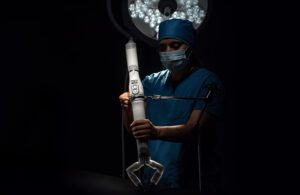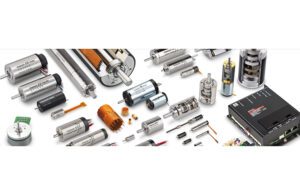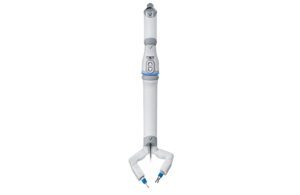
[Photo courtesy of Virtual Incision]
Advancements in robotic-assisted surgery (RAS) systems have led to a small robot that allows surgeons to obtain full multi-quadrant access without the need for docking and re-docking a large, cumbersome external platform.
Carsten Horn, Maxon
Design advances in robotic-assisted surgery (RAS) systems continue to enable operations through small incisions. This is done by providing the surgeon the ability to control robotic arms and cameras with precision. The goal of RAS is to help surgeons perform procedures reproducibly in a minimally invasive manner with advantages such as reduced pain and shorter hospital stays.
As demand for RAS continues to grow, health care facilities are seeking ways to accelerate the expansion of their programs. The goal of Virtual Incision is to offer a way for facilities to add systems and improve their efficiency without disrupting their existing infrastructure. The Lincoln, Nebraska-based company designed and manufactured MIRA, the world’s first miniaturized RAS platform that aims to be easily transported and set up in any operating room.

The Virtual Incision MIRA platform’s console [Photo courtesy of Virtual Incision]
The MIRA system (which stands for “miniaturized in vivo robotic assistant”) includes a surgeon console that provides complete control of the instrument arms and endoscopic vision of the anatomy in real-time and a companion cart to easily transport equipment. Setup is designed to be straightforward. The goal is serve more patients by allowing RAS systems a way into the 90% of operating rooms that do not currently have RAS access.
MIRA is a highly differentiated solution in comparison to the boom- or pedestal-based systems (the “mainframes”) that require a large footprint and are less portable. Such systems are limited to use in spacious operating rooms, which may impede workflow in the OR by requiring more cumbersome setup as well as blocking the vision and movement of support staff.
Virtual Incision’s major engineering challenge during MIRA’s design phase was to create something small, portable, and easy to use while maintaining the strength to perform challenging operations. One example is bowel resection surgery, for which the device is presently part of an IDE study that will support FDA market authorization.
In addition, the company wanted to design the device to be easy to clean and sterilize between cases. This feature would eliminate the draping that most systems on the market require. Draping adds time between procedures, potentially reducing the number of patients who can be treated.
The motion components

Maxon designs and manufactures a complete line of motors, gearboxes, and accessories for a wide variety of motion system applications, which enables a rapid iterative process in the design of MIRA that would meet demanding high speed and torque requirements. [Image courtesy of Maxon]
Virtual Incision chose to work with Maxon during the design of MIRA along with the first-ever articulating camera to be used in an RAS system. The system has demanding requirements due to high speeds and torques. Maxon was in a unique position to support Virtual Incision’s rapid iterative “make-and-improve” design process because of its complete line of motors and world-renowned expertise. Testing and qualification activities are also supported to assure reliability and consistency of the subassemblies going into the MIRA system. Maxon’s team of engineers helped from conception and design to manufacturing of the subsystems. Virtual Incision developed all of the accompanying hardware, firmware and software in-house to optimize miniaturization and device performance characteristics.
The team increased the efficiency of the system and maximized the deliverable output power for each joint. This design feature is what makes MIRA very strong for its size, delivering up to 2 lb of output force anywhere in the workspace while maintaining speed and agility.
A unique approach

MIRA’s rigid arms with motors mounted inside provide strength while fully enabling triangulation of the camera and instruments.
[Photo courtesy of Virtual Incision]
Mainframe-type RAS systems incorporate motors outside of the body, placed on booms or pedestals to give the device enough strength. MIRA gains its strength in a small size by placing the motors inside the body. The rigid (non-snake-like) arms with the motors mounted inside deliver the needed strength while also enabling triangulation of the camera and instruments. The device has been used clinically for bowel resection procedures, and this is the first time the motors for an RAS device have ever operated inside the human body.
The requirements of surgery demand both strength and speed. Through the use of high-efficiency, top-of-the-line motors, MIRA is designed specifically to manipulate large and heavy organs such as the colon. The RAS must be able to mimic the real-time motions of the surgeon to provide quick responses when required.

The Virtual Incision MIRA platform’s arm [Photo courtesy of Virtual Incision]
In addition to strength, colorectal procedures often require the RAS system to reach into multiple quadrants of the abdomen — sometimes all four. Multi-port mainframe systems require careful port placement and procedure choreography to avoid external arm collisions. MIRA’s miniaturized, self-contained design enables full anatomical access without the concern of external arm collisions. Additionally, the articulated camera design ensures proper triangulation between the instruments and camera in all operating scenarios.
As a medical device, special considerations including sterilization, biocompatibility, electrical safety and delivery of electrocautery were all part of the MIRA design.
Virtual Incision believes that the best and most productive approach to innovation is through doing. The company designs products by creating something, testing it profusely and learning everything possible from the experience. This make-and-improve approach enabled the company to implement iterations in minimal time and push the boundaries of the technology, in this case making smaller RAS devices. As a partner, Maxon has provided the technical expertise as well as the willingness to try variations to Virtual Incision’s innovations.
In the end, MIRA is the smallest RAS to soon be on the market. It offers significant strength for its size and enables quick setup in any operating room. This includes outer space, as MIRA will be heading to the International Space Station in 2024 where its skills will be tested by simulating activities performed in surgery, including cutting simulated tissue and manipulating small objects.
Carsten Horn is an applications engineering manager at Maxon Precision Motors. Horn joined Maxon Motor Germany in 2004 as head of R&D for gear boxes and systems and later headed the product management team at Maxon Germany, where he focused on design of components for medical device products.
The opinions expressed in this post are the author’s only and do not necessarily reflect those of MedicalDesignandOutsourcing.com or its employees.